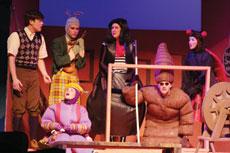Southern Theatre creates hour of ‘magic’

Southern Theatre presented James and the Giant Peach last week as its spring children’s production. The play is based on a Roald Dahl book.
The curtain went up on Missouri Southern’s 39th children’s theatre production last week.
The Show-Me-Celebration Company and the Missouri Southern theatre department produced James and the Giant Peach. Area schoolchildren attended performances Tuesday through Friday before the play was available to the public on the weekend.
The play, based on the book by Roald Dahl, tells the story of James and his escape from his horrible aunts.
After a peach magically grows to gigantic proportions, James and an assortment of newfound friends travel inside it over the Atlantic ocean to a new life.
Cast members worked hard to provide “one hour of adventure, magic, and make-believe,” said Kelsey Amann, sophomore theatre major.
Amann played several parts, including a reporter and the head of the rhinoceros which kills James’ parents.
Pam Claussen, director of the play, said there were 14 characters in the play and only six actors.
“We are constantly changing costumes backstage,” she said. “We move at a very rapid pace.”
Heather Freelend, senior teacher education major, was among those with multiple roles. Her parts included James’ mother, his Aunt Sponge, a sailor, and the ladybird.
“It’s been a lot of fun,” Freelend said. “We definitely found our inner children.”
Seven-year-old Jude Rosebaugh watched the play with his younger brother, Jack, and their aunt on Wednesday. Both boys said the play was “awesome!”
Claussen said producing a play for children has unique challenges.
“We look for something energetic that they’ll have fun with, that can help teach them something and teach us things,” she said.
In James and the Giant Peach, a unique set design was employed. Three triangular columns, called “Periaktoi,” were placed along each side of the stage. The columns, which had different motifs painted on each side, were rotated to change the scene from a countryside to the ocean to underwater.
The audience was allowed to participate in the play several times. At one point, children in the audience propelled the “peach” – in reality a large, soft orange ball – all the way to the stage.
“We get different reactions with every audience,” Claussen said. “That makes children’s theatre a lot of fun.”
Your donation will support the student journalists of Missouri Southern State University. Your contribution will allow us to purchase equipment and cover our annual website hosting costs.



























